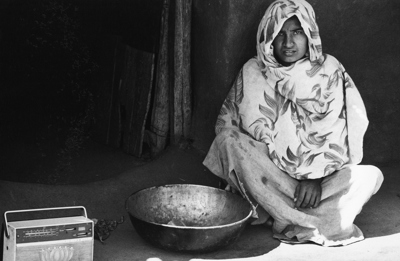The Villages of India. Photographs by Gianni Berengo Gardin

Berengo Gardin is an autodidact, and his genre can be termed “humanistic documentation”
The winter season’s photo exhibition presents work by one of Italy’s greatest living photographers, Gianni Berengo Gardin, born in 1930. The over 50 black-and-white photographs were all taken during his travels in India between 1977 and 1979, and this is the first time that a selection of Berengo Gardin’s photographic art can be seen in Denmark.
Berengo Gardin is an autodidact, and his genre can be termed “humanistic documentation.” What proved decisive for his documentary style in 1954 was seeing the work of the great American photographers Dorothea Lange and Walker Evans, showing the effects of poverty in the Great Depression. During an ensuing two-year stay in Paris, Berengo Gardin became acquainted with work by pioneers of French documentary photography such as Villy Ronis, Édouard Boubat, and Robert Doisneau.
Berengo Gardin was fascinated by Mahatma Gandhi while still at school. Inspired by Gandhi’s belief that the real India is to be found not in its cities, but in its countless villages, Berengo Gardin decided to photograph the villages of India when he visited the country for the first time in 1977. His first visit was followed by others, and in 1979, he explored the rural areas around the city of Indore on the Malwa Plateau (Madhya Pradesh) in central India. During the changing seasons – dry periods and wet monsoons – he photographed simple, everyday life as it unfolded inside village houses, in the streets, and in the countryside. In many cases, the local people are the main motif, while in others, the surroundings play a more dominant role, in which light and shadow or reflections in the water give the photographs more abstract qualities.
The selection of photographs shown in this exhibition reflects the wide scope of the photographer’s Indian motifs. The choice also takes into account the museum’s Indian holdings, as the photographs include obvious parallels to a group of miniatures from the end of the 18th and beginning of the 19th century. These “Company paintings” were made by Indian artists for English clients, and thus bear witness to an interest in documenting the India that especially the British encountered. The finest miniatures from the “Fraser albums,” in particular, are depictions that have an artistic kinship to Berengo Gardin’s photographs of rural life. See examples from the website here. They show real people who pose in the same way as the subjects in the photographs, wearing local garments and in some cases also set against a village background. Together, Berengo Gardin’s photographs and the museum’s miniatures consequently bear witness to decades of continuity in Indian village communities, something that has been challenged in the 21st century by India’s economic growth and the explosive expansion of its metropolises.
Gianni Berengo Gardin has authored more than 250 books of photographs, most of which are black-and-white, all made using traditional film. He is a steadfast opponent of digital photography and the ways in which its products can be finished and manipulated.
Information
Free admission to the David Collection and the special exhibition.
For further information, contact:
Joachim Meyer, curator